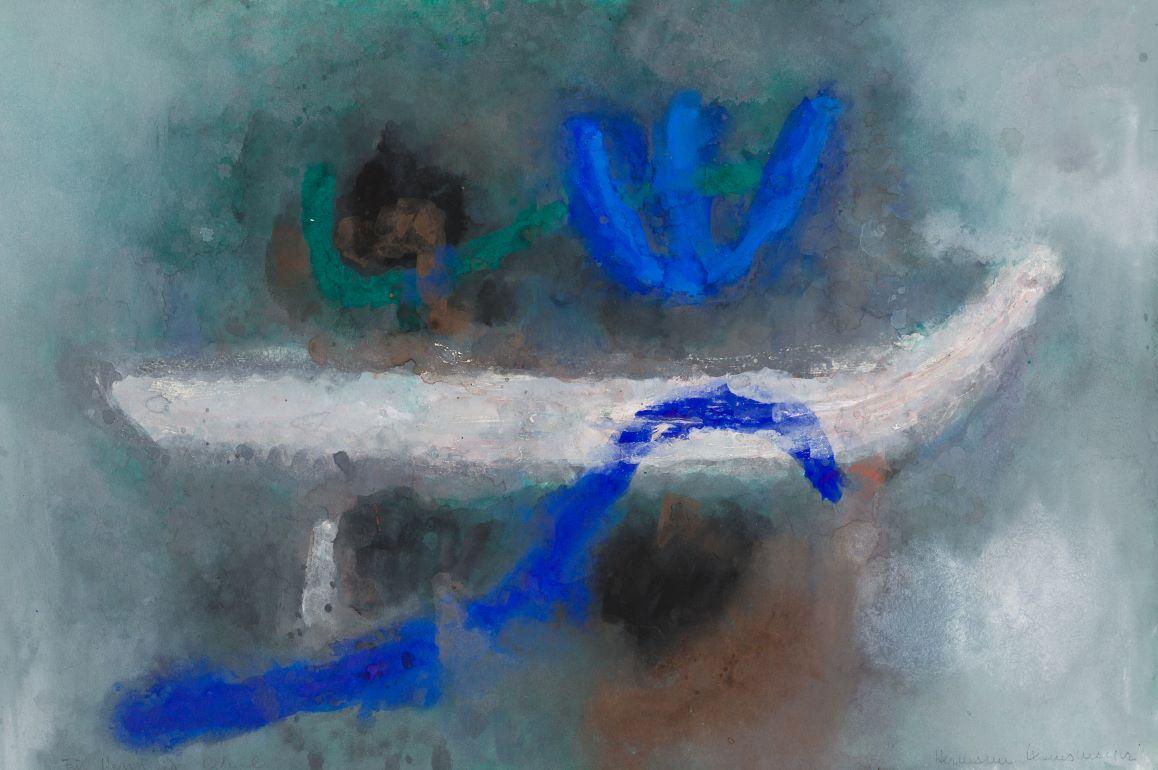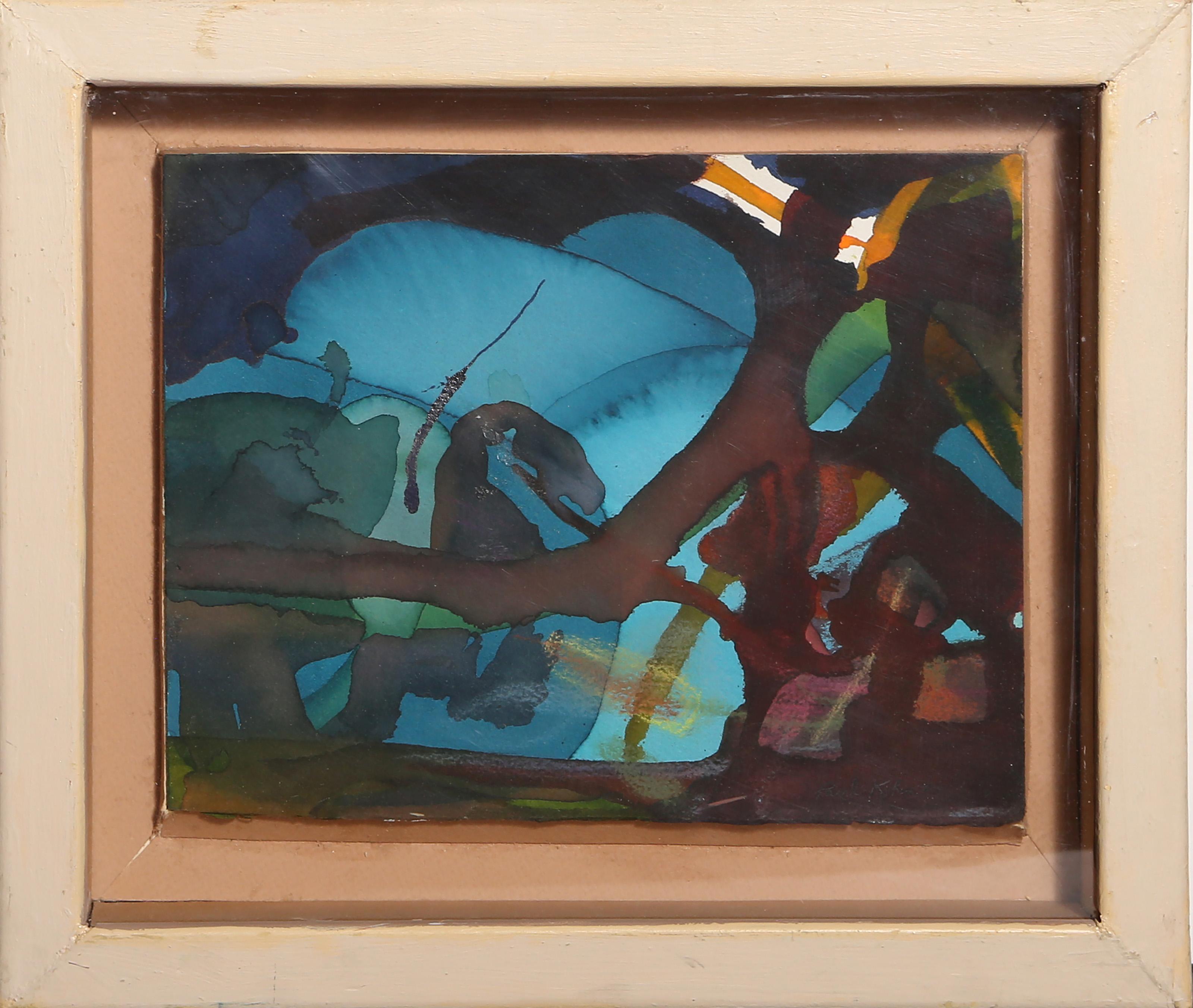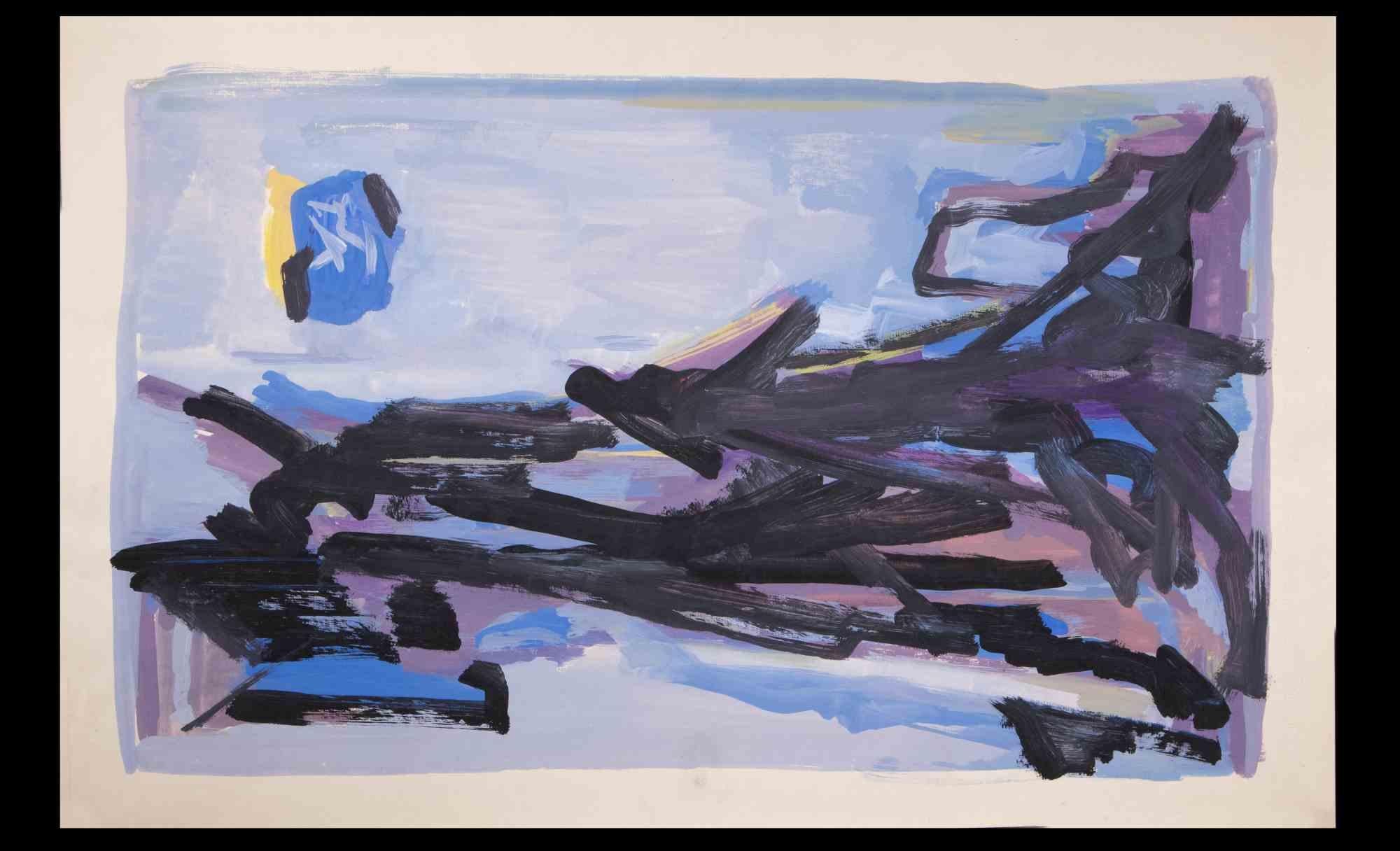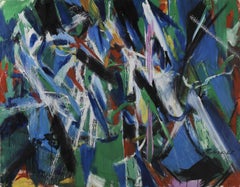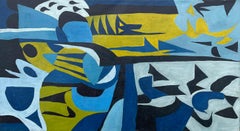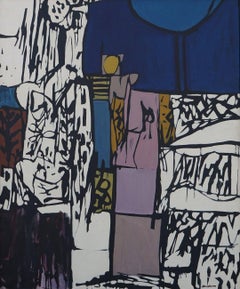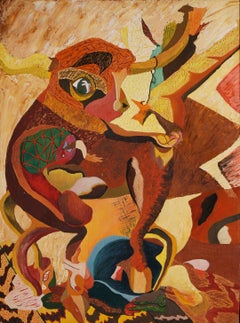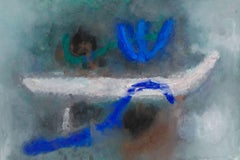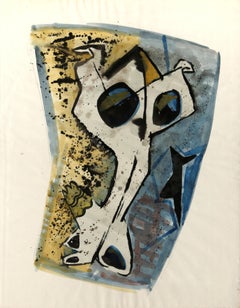Items Similar to The Blue Earth II, CoBrA movement, Mid-20th Century Danish Watercolor
Video Loading
Want more images or videos?
Request additional images or videos from the seller
1 of 15
Carl-Henning PedersenThe Blue Earth II, CoBrA movement, Mid-20th Century Danish Watercolor1971
1971
$10,500
£7,971.42
€9,117.61
CA$14,670.02
A$16,316.27
CHF 8,519.85
MX$198,551.62
NOK 108,811.46
SEK 102,045.95
DKK 68,048.18
Shipping
Retrieving quote...The 1stDibs Promise:
Authenticity Guarantee,
Money-Back Guarantee,
24-Hour Cancellation
About the Item
Carl-Henning Pedersen (Denmark, 1913 - 2007)
The Blue Earth II, 1971
Watercolor on paper
Signed and dated lower right, signed, dated and titled verso
30.5 x 21.5 inches
Carl-Henning Pedersen was born in Copenhagen in 1913. At an early age he began taking part in politics, first in the youth association of social democrats and later in the youth association of communists, which better suited his revolutionary activist nature against fascism. In 1933, he attended the public high school of Humblebaek where he met the painter Else Alfelt, who he would marry in 1934 and with whom he would have two daughters. For many years the family divided its time between Copenhagen and the city of Bovbjerg, located on the North Sea, where Carl and Else had a studio. Between 1935 and 1940, Pedersen started to sketch and paint.
He exhibited for the first time, together with his wife, in “Kunstnernes Efterårsudstilling” (The Artists' Fall Exhibition) in Copenhagen in 1936. Pedersen associated with the young painters close to abstract movements, and like them, worked under difficult conditions. He went to Paris in 1939, where he encountered the work of Picasso, Matisse and Chagall.
Between 1940 and 1945, he contributed to the journal Helhesten. In the same journal, Pedersen published the text "Arte astratta o arte immaginaria," that supplied the most complete and precise definition, up to that point, of the work principles of the young generation of painters, of which he was a part. This definition, in many ways, was close to that which would be the program of the group Cobra. Between 1945 and 1960, the Danish artists went abroad and, along with Dutch and Belgian artists, founded the group Cobra, which was active between 1948 and 1951. During this period in 1948, Pedersen participated in the Biennial of Venice. He exhibited extensively with Cobra in shows such as its first important show which was held at the Stedelijk Museum of Amsterdam in 1949, “International Experimental Art.” Afterwords, Pedersen distanced himself from the group and began to travel frequently. His destinations included Greece, Italy, France, Switzerland, Norway, Lapland, Iceland, Turkey, Nepal, and Jerusalem.
He received the Eckersberg Award in 1950 from the Royal Danish Academy of Art. In 1952, he participated in “Contemporary Drawings from 12 Countries, 1945/1952,” an exhibition held at the Toledo Museum of Art in Toledo, Ohio, the exhibition also traveled to other museums in the United States, while in 1955, he took part in the group exhibition “Expressionism 1900/1955,” at the Walker Art Center in Minneapolis (also a traveling exhibition throughout the United States).
He participated in the 1952, 1955, 1958, 1961, 1964, and 1967 editions of “The Pittsburgh International Exhibition of Contemporary Painting and Sculpture” at the Museum of Art of the Carnegie Institute in Pittsburgh. The same museum also honored him with solo exhibitions in 1961 and 1968. In 1966, he exhibited at the Solomon R. Guggenheim Museum of New York in the show “European Drawings” that also traveled to Hawaii, Canada, Argentina, and Germany. In 1967, he showed at the “2. Internationale der Zeichnung” in Darmstadt, and then in 1968, he participated in the Premio Marzotto and the “Exhibition of Expressionist Art after 1950” at the Kunstmuseum of Lucerne, which then toured in Romania, Australia, Belgium, and Finland.
Pedersen received the medal of Prince Eugen in 1980, and he participated in the exhibition “Danish Artists, Carl-Henning Pedersen, Else Alfelt, Egil Jacobsen” in Budapest and Warsaw, while in November he had a solo exhibition at Lorenzelli Arte in Milan. During the same year, he completed 13 large paintings and 20 of smaller dimensions in Italy, near Siena. In 1982, he exhibited in the show “Grönningen” in Copenhagen and also in the “Cobra” exhibition hosted by the Musée d'Art Moderne de la Ville de Paris. In 1983, the inauguration of the painting on glass that was made for the Museum of the Resistance of the Second World War of Copenhagen, entitled The Light of Liberty, took place. In addition, a series of retrospective exhibitions took place: one of paintings and watercolors at the Louisiana Museum, one of drawings and watercolors in Copenhagen, and one of paintings at the Modern Museum of Art, Henie and Onstad Museum, in Norway. Pedersen was asked by the National Fund for the Endowment of the Arts (Statens Kunstfond) to take on the redecoration of the Ribe Cathedral, decorating it with mosaics, glass paintings, and frescos, giving his own, very personal interpretation of Biblical stories and motifs.
Works by Pedersen can be found in the collections of important museums throughout the world: Albright-Knox Art Gallery, Buffalo, New York; Göteborg Kunstmuseum, Gothenburg, Sweden; Louisiana Museum, Humblebaek, Denmark; Museum of Art, Carnegie Institute, Pittsburgh; MoMA, New York; Nasjonalgalleriet, Oslo, Norway; Nordjyllands Museum, Åalborg, Denmark; State Museum of Copenhagen; Stedelijk Museum, Amsterdam; Moderna Museet, Stockholm; and the State Museum of Bucharest.
He died in Copenhagen on 20 February 2007, after a long illness.
- Creator:Carl-Henning Pedersen (1913 - 1993, Danish)
- Creation Year:1971
- Dimensions:Height: 30.5 in (77.47 cm)Width: 21.5 in (54.61 cm)
- Medium:
- Movement & Style:
- Period:
- Framing:Framing Options Available
- Condition:
- Gallery Location:Beachwood, OH
- Reference Number:1stDibs: LU1768212412602
Carl-Henning Pedersen
Carl-Henning Pedersen was one of the most influential post-war artists in Denmark. He was a prominent member of the COBRA art movement. Pedersen's artworks are characterized by the representation of a mythological world in which recurring creatures can be recognized like birds and horses. In his work, he used experimental forms and fluid lines. In 1950, there was a retrospective of his work in Copenhagen, followed by several solo and group exhibitions. His work was shown at the Venice Biennale of 1962, twice in New York City (1973 and 1976). In 1976, a dedicated museum was opened for his work in Herning, Denmark.
About the Seller
5.0
Vetted Professional Seller
Every seller passes strict standards for authenticity and reliability
Established in 1975
1stDibs seller since 2022
34 sales on 1stDibs
Typical response time: 1 hour
- ShippingRetrieving quote...Shipping from: Beachwood, OH
- Return Policy
Authenticity Guarantee
In the unlikely event there’s an issue with an item’s authenticity, contact us within 1 year for a full refund. DetailsMoney-Back Guarantee
If your item is not as described, is damaged in transit, or does not arrive, contact us within 7 days for a full refund. Details24-Hour Cancellation
You have a 24-hour grace period in which to reconsider your purchase, with no questions asked.Vetted Professional Sellers
Our world-class sellers must adhere to strict standards for service and quality, maintaining the integrity of our listings.Price-Match Guarantee
If you find that a seller listed the same item for a lower price elsewhere, we’ll match it.Trusted Global Delivery
Our best-in-class carrier network provides specialized shipping options worldwide, including custom delivery.More From This Seller
View AllLarge 20th century abstract painting by contemporary Ohio artist, 3.5 x 4.5 feet
Located in Beachwood, OH
James Lepore (American, 1931-2024)
Untitled (Abstract), 1962
Oil on canvas
Signed Lepore 62 lower right
43 x 55 inches
James Lepore was an American artis...
Category
1960s Abstract Abstract Paintings
Materials
Oil
Abstract expressionist blue, black & green mid-century geometric painting
By Richard Andres
Located in Beachwood, OH
Richard Andres (American, 1927-2013)
Untitled, c. 1949
oil on canvas
18 x 32 inches
Richard Andres was born in Buffalo, New York in 1927. A graduate of the Cleveland Institute of Art in 1950, he was immediately drafted and served for two years in the army as a mural painter. He received his Master of Arts from Kent State in 1961. A frequent exhibitor at galleries and museums and winner of multiple May Show prizes, Andres taught art in the Cleveland Public Schools for 28 years, as well as teaching the University of Buffalo, the Cleveland Institute of Art and the Western Reserve University.
Very little in Richard Andres’ childhood would have predicted his love of classical music, mid-century-modern architecture and certainly not his lifelong passion for art and in particular abstract art. Richard’s father, Raymond, had no more than a third-grade education, and his mother, Clara, was one of thirteen children – only three of whom lived into adulthood and none of whom attended high school.
They lived, when Richard was a boy, in a dingy area of Buffalo, NY in a walk-up apartment situated above a tavern. Raymond and Clara supplemented the income from their factory jobs in the bar downstairs with Raymond playing ragtime on the piano and Clara serving drinks. This often left Richard and his two older brothers at home alone to fend for themselves. The two older boys, Raymond and Russell, were - unlike Richard- rather rough and tumble and entertained themselves with stickball, boxing and the like. Richard, on the other hand, from a very young age liked to draw, or better yet even, to paint with the small set of watercolors he received for Christmas one year. Paper, however, at the height of the depression, was hard to come by. Luckily, Clara used paper doilies as decoration for the apartment and Richard would contentedly paint and then cut up doilies, gluing the pieces together to create collages.
At eight-years-old, he discovered the Albright-Knox Museum (then known as the Albright Art Gallery) and spent several hours a week there studying the paintings. He was particularly fond of Charles Burchfield‘s landscapes, enamored with their ‘messiness’ and thinking that they somehow captured more ‘feeling’ than works he was previously familiar with. For his tenth Christmas, he asked for and received a ‘how-to’ paint book by Elliot O’Hare. Through this self-teaching, he assembled the portfolio needed for acceptance to Buffalo Technical High School where he studied Advertising Arts. In his Junior year, he was encouraged to enter a watercolor painting, “Two Barns,” in the national 1944-45 Ingersoll Art Award Contest and was one of twelve grand prize winners – each one winning one hundred dollars. More importantly the painting was exhibited at the Carnegie Institute Galleries, which resulted in his winning a national scholarship to the Cleveland School of Art (The Cleveland Art Institute).
He flourished at the art school under the tutelage of faculty members such as Carl Gaertner, as well as that of visiting artists such as William Sommer and Henry George Keller. He would say in later years that Gaertner, in particular, influenced his attitude toward life as well as art. “Gaertner,” Andres said, “believed that there was no need to be a ‘tortured artist’, that an artist should rather enjoy beauty, family, and life in general.” Free to spend his days as he chose, he wandered the Cleveland Art Museum for most of the hours he was not attending classes or painting; the remaining time was spent drinking coffee at a local hangout with art school friends – which is where he met fellow Henry Keller scholarship winner, Avis Johnson. Richard was immediately smitten with Avis, but being rather shy, it took him the entire summer of 1948 to build up his courage to ask her out. Over that summer he ‘thought about Avis’ and worked in a diner to save money. He also used the hundred-dollar prize money won in High School to visit the first Max Beckmann retrospective in the United States at the City Art Museum in St. Louis. Over a half century later he spoke of that exhibit with a reverence usually reserved for spiritual matters, “I walked in and it was like nothing I had ever seen before... the color...It just glowed.”
Returning to campus in the Fall, the first thing he did was go to the coffee shop in hopes of finding Avis. He did, and she, upon seeing him, realized that she was also smitten with him. They quickly became known as ‘the couple’ on campus, and a year later, with Richard being drafted for the Korean war, they were quickly married by a Justice of the Peace, celebrating after with family at Avis’s Cleveland home. As a gift, faculty member John Paul Miller designed and made the simple gold wedding ring Avis wore for their 65 years of marriage. During those 65 years neither wavered in their mutual love, nor in the respect they shared for one another’s art.
The couple lived in a converted chicken coop in Missouri while Richard was in boot camp. At the camp, he would volunteer for any job offered and one of those jobs ended up being painting road signs. His commander noticed how quickly and neatly he worked and gave him more painting work to do - eventually recommending him for a position painting murals for Army offices in Panama. Until her dying day, Avis remained angry that “The army got to keep those fabulous murals and they probably didn’t even know how wonderful they were.” In Panama, their first son, Mark, was born. After Richard’s discharge in 1953, they moved back to the Cleveland area and used the GI bill to attend Kent State gaining his BA in education. The small family then moved briefly to Buffalo, where Richard taught at the Albright Art School and the University of Buffalo – and their second son, Peter, was born. Richard had exhibited work in the Cleveland May Show and the Butler Art Museum during his art school years, and during the years in Buffalo, his work was exhibited at the gallery he had so loved as a child, the Albright Art Gallery.
In 1956, the family moved back to the Cleveland area and Richard began teaching art at Lincoln West High School during the day while working toward his MA in art at Kent State in the evenings. Avis and Richard, with the help of an architect, designed their first home - a saltbox style house in Hudson, Ohio, and in 1958, their third son, Max (after Max Beckmann) was born. Richard enjoyed the consistency of teaching high school as well as the time it gave him to paint on the weekends and during the summer months. In 1961, he received his MA and his daughter, Claire, was born. With a fourth child, the house was much too small, and Avis and Richard began designing their second home. An admirer of MCM architecture, Richard’s favorite example of the style was the Farnsworth house – he often spoke of how the concepts behind this architectural style, particularly that of Mies van der Rohe, influenced his painting.
Andres described himself as a 1950’s...
Category
1940s Abstract Expressionist Abstract Paintings
Materials
Oil
Panama Garden, Mid-century abstract expressionist modern work
By Richard Andres
Located in Beachwood, OH
Richard Andres (American, 1927-2013)
Panama Garden, c. 1964
acrylic on canvas
signed lower right, signed and titled verso
46 x 38 inches
Richard Andres was born in Buffalo, New York in 1927. A graduate of the Cleveland Institute of Art in 1950, he was immediately drafted and served for two years in the army as a mural painter. He received his Master of Arts from Kent State in 1961. A frequent exhibitor at galleries and museums and winner of multiple May Show prizes, Andres taught art in the Cleveland Public Schools for 28 years, as well as teaching the University of Buffalo, the Cleveland Institute of Art and the Western Reserve University.
Very little in Richard Andres’ childhood would have predicted his love of classical music, mid-century-modern architecture and certainly not his lifelong passion for art and in particular abstract art. Richard’s father, Raymond, had no more than a third-grade education, and his mother, Clara, was one of thirteen children – only three of whom lived into adulthood and none of whom attended high school.
They lived, when Richard was a boy, in a dingy area of Buffalo, NY in a walk-up apartment situated above a tavern. Raymond and Clara supplemented the income from their factory jobs in the bar downstairs with Raymond playing ragtime on the piano and Clara serving drinks. This often left Richard and his two older brothers at home alone to fend for themselves. The two older boys, Raymond and Russell, were - unlike Richard- rather rough and tumble and entertained themselves with stickball, boxing and the like. Richard, on the other hand, from a very young age liked to draw, or better yet even, to paint with the small set of watercolors he received for Christmas one year. Paper, however, at the height of the depression, was hard to come by. Luckily, Clara used paper doilies as decoration for the apartment and Richard would contentedly paint and then cut up doilies, gluing the pieces together to create collages.
At eight-years-old, he discovered the Albright-Knox Museum (then known as the Albright Art Gallery) and spent several hours a week there studying the paintings. He was particularly fond of Charles Burchfield‘s landscapes, enamored with their ‘messiness’ and thinking that they somehow captured more ‘feeling’ than works he was previously familiar with. For his tenth Christmas, he asked for and received a ‘how-to’ paint book by Elliot O’Hare. Through this self-teaching, he assembled the portfolio needed for acceptance to Buffalo Technical High School where he studied Advertising Arts. In his Junior year, he was encouraged to enter a watercolor painting, “Two Barns,” in the national 1944-45 Ingersoll Art Award Contest and was one of twelve grand prize winners – each one winning one hundred dollars. More importantly the painting was exhibited at the Carnegie Institute Galleries, which resulted in his winning a national scholarship to the Cleveland School of Art (The Cleveland Art Institute).
He flourished at the art school under the tutelage of faculty members such as Carl Gaertner, as well as that of visiting artists such as William Sommer and Henry George Keller. He would say in later years that Gaertner, in particular, influenced his attitude toward life as well as art. “Gaertner,” Andres said, “believed that there was no need to be a ‘tortured artist’, that an artist should rather enjoy beauty, family, and life in general.” Free to spend his days as he chose, he wandered the Cleveland Art Museum for most of the hours he was not attending classes or painting; the remaining time was spent drinking coffee at a local hangout with art school friends – which is where he met fellow Henry Keller scholarship winner, Avis Johnson. Richard was immediately smitten with Avis, but being rather shy, it took him the entire summer of 1948 to build up his courage to ask her out. Over that summer he ‘thought about Avis’ and worked in a diner to save money. He also used the hundred-dollar prize money won in High School to visit the first Max Beckmann retrospective in the United States at the City Art Museum in St. Louis. Over a half century later he spoke of that exhibit with a reverence usually reserved for spiritual matters, “I walked in and it was like nothing I had ever seen before... the color...It just glowed.”
Returning to campus in the Fall, the first thing he did was go to the coffee shop in hopes of finding Avis. He did, and she, upon seeing him, realized that she was also smitten with him. They quickly became known as ‘the couple’ on campus, and a year later, with Richard being drafted for the Korean war, they were quickly married by a Justice of the Peace, celebrating after with family at Avis’s Cleveland home. As a gift, faculty member John Paul Miller...
Category
1960s Abstract Expressionist Abstract Paintings
Materials
Acrylic
20th C. Figurative Abstract Painting Cleveland School African American Artist
By Beni E. Kosh
Located in Beachwood, OH
Beni E. Kosh/Charles Elmer Harris (American, 1917-1993)
Untitled
Oil on canvas board
Estate stamped #611 verso
24 x 18 inches
Charles Elmer Harris was born in 1917 in Cleveland, Oh...
Category
20th Century American Modern Figurative Paintings
Materials
Oil
Abstract Landscape, large mid-century green painting, COBRA art movement
Located in Beachwood, OH
Erik Ortvad (Danish, 1917 - 2008)
Abstract Landscape, 1946
Oil on canvas
Signed and dated lower right
32 X 37.5 inches
35 x 40.5 inches, framed
Born in 1917 in Copenhagen, Erik Ortvad was a surrealist painter and a founding member of the COBRA art...
Category
1940s Abstract Impressionist Abstract Paintings
Materials
Oil
Untitled abstract expressionist oil painting by Cleveland School artist
By Richard Andres
Located in Beachwood, OH
Richard Andres
American, 1927-2013
Untitled, c. 1980
acrylic and ink on paper mounted on canvas
30 x 34 inches
Richard Andres was born in Buffalo, New York in 1927. A graduate of th...
Category
1980s Abstract Expressionist Abstract Paintings
Materials
Ink, Acrylic
You May Also Like
Blue Composition
Located in Wien, 9
Hermann Kremsmayer, born in Salzburg in 1954, lives and works in Vienna.
This work, entitled ‘Blue composition’ by Hermann Kremsmayer, shows a play between colours. Bright colours s...
Category
21st Century and Contemporary Abstract Abstract Drawings and Watercolors
Materials
Paper, Gouache
Contemporary Watercolor Painting, 'Design for Space', C. 2005 by David Ruth
By David Ruth
Located in Oakland, CA
This is a contemporary abstract watercolor painting by artist David Ruth. This series of paintings often feature bright colors and vibrant layouts that draw the viewer in. They are c...
Category
Early 2000s Abstract Expressionist Abstract Paintings
Materials
Paper, Watercolor
Contemporary Watercolor Painting, 'Design for Sculpture', c. 2000 by David Ruth
By David Ruth
Located in Oakland, CA
This is a contemporary abstract watercolor painting by artist David Ruth. This series of paintings often feature bright colors and vibrant layouts that draw the viewer in. They are c...
Category
Early 2000s Abstract Expressionist Abstract Paintings
Materials
Paper, Watercolor
Abstract #1, Watercolor Painting on Paper by Chris Ritter
Located in Long Island City, NY
This unique abstract work is a watercolor by American artist Chris Ritter. The use of broad gestural movement and bold colors creates an engaging composit...
Category
1960s Abstract Drawings and Watercolors
Materials
Watercolor
Abstract Blue Composition, Abstract Watercolor and Pastel by Paul Kohn
Located in Long Island City, NY
Paul Kohn - Abstract Blue Composition, Year: 1970, Medium: Watercolor and pastel on paper, signed and dated in pencil lower right and on verso, Size: 8.25 x 11 x 2.75 in. (20.96 x...
Category
1970s Abstract Abstract Drawings and Watercolors
Materials
Pastel, Watercolor
Abstract Composition in Blue - Etching by Émile Marze - 1980s
Located in Roma, IT
Abstract Composition in Blue is a painting in tempera and watercolor on ivory-colored paper, realized in the 1980s by French artist Émile Marze (1930-2009).
Good condition.
The ar...
Category
1980s Contemporary Figurative Prints
Materials
Etching
More Ways To Browse
German Expressionists Drawings
Dior 1971
Jerusalem Drawing
The New York Collection For Stockholm
Cobra Art
Blue Hawaii
Danish Mid Century Abstract
Mid Century Painting Denmark
Picasso Blue Period
Cobra Art Signed
Mid Century Art Norwegian
German Early 20th Century Expressionist Painting
Hen Painting
Nepal Painting
French Hen
Danish Mid Century Abstract Paintings
Art Glass Made In Norway
Dior Blue Suit
